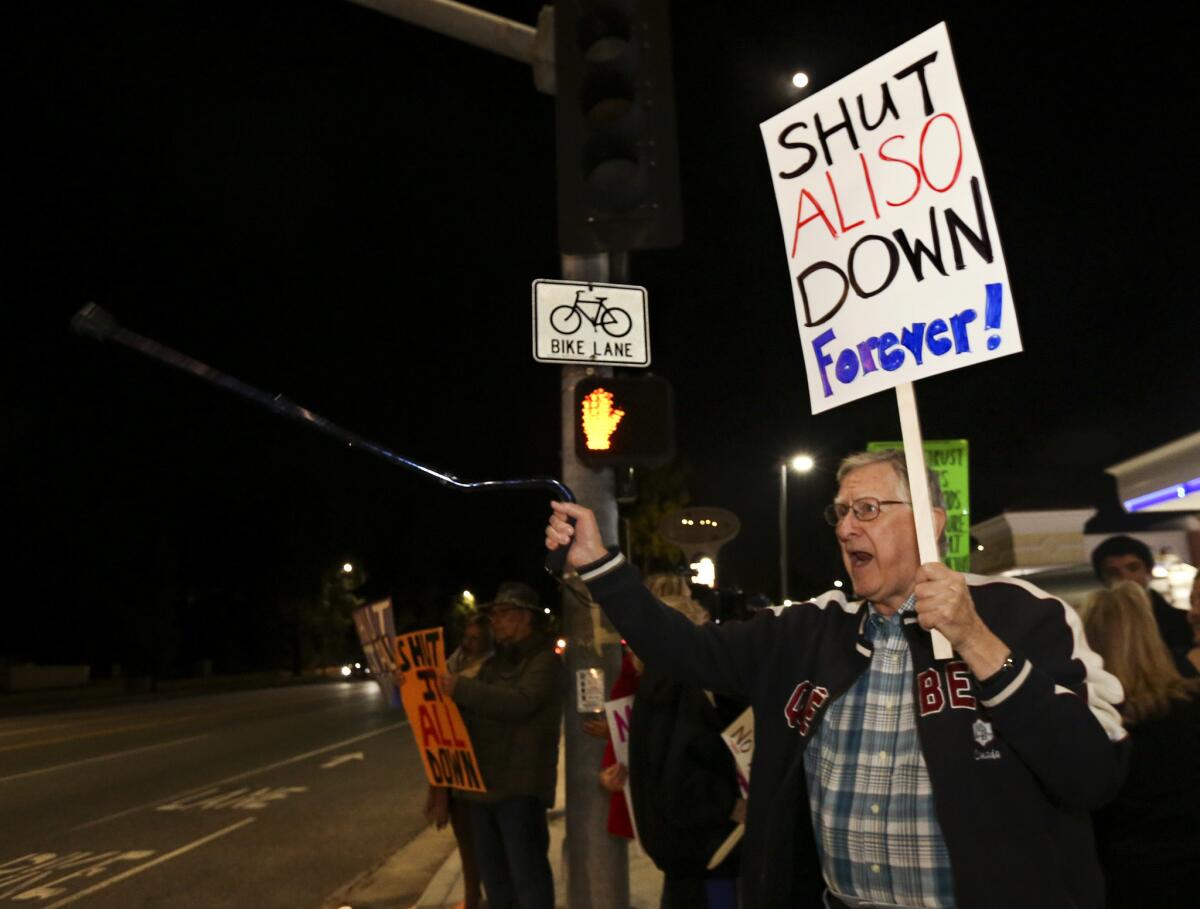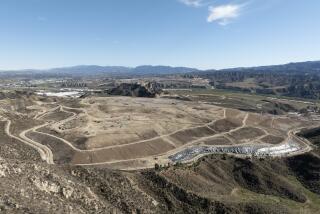Southern California Gas using enhanced leak detection and inspections at Aliso Canyon

John Gutierrez, 77, a member of the group Save Porter Ranch, joins a February protest calling for Southern California Gas’ Aliso Canyon storage facility to be shut down.
- Share via
Southern California Gas Co. is starting enhanced leak detection and inspections of its troubled Aliso Canyon natural gas storage facility to help protect nearby communities, its chief executive said Friday.
In addition, an independent engineering firm will conduct a review of the four-month leak at the facility to determine the cause, Dennis Arriola, the gas company’s president and CEO, said during a conference call to discuss the better-than-expected earnings of parent company Sempra Energy.
Southern California Gas stopped the leak Feb. 18 but not before fouling the air with tens of thousands of tons of natural gas and methane. The problem — the largest methane leak in U.S. history — forced thousands of residents from their homes, with some people complaining of illness from the fumes.
Sempra executives said in the San Diego company’s earnings call Friday that estimated costs related to the leak are $330 million. Insurance policies have a combined limit of $1 billion, the company stated.
The company said the state Department of Oil, Gas & Geothermal Resources and the California Public Utilities Commission are conducting investigations. If those investigations lead to fines, the company said it expects insurance to cover at least part of that amount.
“Our insurance coverage is quite broad,” said Martha Wyrsch, Sempra vice president and general counsel. “We do believe that in certain circumstances … insurance should cover fines and penalties.”
Attention now has turned to bringing the storage field, the largest in California and fifth-largest in the country, back into full operation — although many residents would prefer to see Aliso Canyon permanently closed.
State energy agencies have told Gov. Jerry Brown that they believe Aliso Canyon is crucial to ensuring the reliability of Southern California’s energy system, including the electric grid. The storage facility supplies about 60% of the natural gas that the company’s customers consume.
“We’re optimistic that sounder minds recognize the importance of getting Aliso back online as soon and safely as possible,” Arriola said.
He said the utility is examining the 115 wells at the storage facility but did not have a time frame for how long it would take to inspect them all. He said some wells could come back online before the entire facility is inspected.
Arriola added that Southern California Gas has requested additional funds in its general rate case for its “storage integrity management program,” which helps with maintenance of the utility’s four natural gas storage fields, including Aliso Canyon. If approved by state regulators, the costs would be paid by customers.
He said the utility began a pilot of the storage integrity program in 2014. The additional funds would support continuing the program.
Critics of Southern California Gas’ handling of Aliso Canyon contend that customers should not be held financially responsible for fixing the problem at the storage field.
“To the extent that they now need to take corrective action because of neglect or mismanagement, obviously those costs should be borne by shareholders,” said Mindy Spatt, a spokesperson for the Utility Reform Network, a ratepayer advocacy organization.
Michael Aguirre, a San Diego lawyer who has been one of the most vocal critics of California’s power and gas utilities, said the Public Utilities Commission shouldn’t approve any funding for Aliso Canyon issues without serious accountability.
“Southern California Gas is seeking to exploit the catastrophe by claiming an increase in rates will be for integrity, but utility customers can have no confidence there is integrity enough in Southern California Gas,” Aguirre said. “Before they get the money, we need the CPUC to complete its investigation.”
U.S. Rep. Brad Sherman (D-Porter Ranch) said during a recent news conference about the Aliso Canyon leak that he believed Sempra Energy shareholders, rather than gas company ratepayers, should bear the costs related to fixing the leak.
Sherman and state Sen. Fran Pavley (D-Agoura Hills) want, at a minimum, improvements to ensure the safety of the wells before Southern California Gas starts pumping gas back into them. They would like wells sealed to protect against leaks; infrared cameras installed so residents can see what’s going on inside the storage units; and shut-off valves added to serve as a stopgap measure if something goes wrong.
Sherman also said utilities must be prevented from relying so heavily on a few huge facilities, as Southern California Gas did with Aliso Canyon.
The U.S. Energy Information Administration issued a brief statement of concern Feb. 1 about the “implications for energy system reliability in the region” from any loss of storage at Aliso Canyon. The agency is reviewing the issue, noting: “It is not yet clear how much storage capacity will be available at the Aliso Canyon facility, and in what time frame.”
Those who advocate closing the storage facility contend that the four-month leak shows material weakness at Aliso Canyon that poses serious concern to human health and safety.
Despite the costs of the Aliso Canyon leak, Sempra on Friday posted fourth-quarter net income of $369 million, or $1.47 a share, beating company guidance and Wall Street forecasts. But revenue was $2.7 billion, below analysts’ estimates.
In the same quarter of 2014, Sempra earned $297 million, or $1.18 a share, on revenue of $2.75 billion.
ivan.penn@latimes.com
More to Read
Inside the business of entertainment
The Wide Shot brings you news, analysis and insights on everything from streaming wars to production — and what it all means for the future.
You may occasionally receive promotional content from the Los Angeles Times.











